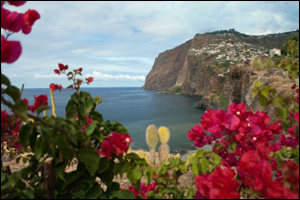 At the outermost reaches of the European Union lies a group of islands that Roman philosopher Pliny the Elder referred to as the “Purple Islands”. Soon after Pliny’s observation, military commander Quintus Sertorius came across the same landmasses and wrote of “the Isles of the Blessed”.
At the outermost reaches of the European Union lies a group of islands that Roman philosopher Pliny the Elder referred to as the “Purple Islands”. Soon after Pliny’s observation, military commander Quintus Sertorius came across the same landmasses and wrote of “the Isles of the Blessed”.
What islands in the North Atlantic Ocean could possibly have garnered such enchanting labels from ancient explorers? They were, in fact, the islands that make up the archipelago of Madeira, an autonomous region of what is now Portugal.
Approximately 320 miles off the North African coast, and 620 miles from the European continent, the archipelago of Madeira is composed of several volcanic islands that are at least 20 million years old.
The largest and main island of Madeira was created by thousands of years of volcanic flow, which has long since ceased. The result is an incredible display of mountain ranges reaching 6000 feet above sea level, lush green valleys and dramatic long beaches. The volcanic history of the island has made its mark on every aspect of the environment, but especially the soil.
The unique soil composition has produced a rare type of forest that is so precious; UNESCO has deemed it a World Heritage Site. The Laurisilva forest is exclusive to subtropical areas with high humidity and mild temperatures that remain stable for much of the year. In addition to the various laurel species of trees, Madeira soil also produces incredible floras all year long and in great quantities. Could it be that the year-round mild temperatures, combined with the rare Laurisilva forests and cascades of vibrant flowers all over the mountainsides inspired such a name as the Purple Islands?
Hospitality and Culture at its Best
The island of Madeira is relatively small, just 459 square miles in area. Yet what lies within those miles is exceptional natural beauty, a rich culture and hospitality that rivals even the sweetest of grandparents. The Portuguese are a hard working and generous people. They are fiercely proud of their heritage, and always sensitive to a visitor’s comfort.
The Portuguese tradition of robust cuisine, and equally robust wine, is evident in the daily comings and goings of Madeira residents. Freshly baked loaves and buns are loaded into baskets and brought to market. Rows and rows of still-breathing-it’s-so-fresh seafood of all varieties await the market shoppers. There is of course freshly harvested produce as well; and of such diversity, even the most well traveled visitor couldn’t identify every offering.
Despite the small size of the island, and the down-to-earth attitude of the locals, Madeira has a thriving tourist industry. Unlike many other world tourism hot spots, Madeira has managed to stay true to it’s old world culture in the midst of catering to visitors. Perhaps the practical hospitality and national pride keep westernized commercialism from destroying Portuguese culture in Madeira. Whatever the reason, Madeira has a beautiful thing going: unrivalled unique natural beauty, bountiful and ancient culture, genuine hospitality, and tourism facilities that do not spoil their surroundings.
About the author: Diamond Resorts International is a group of superior resort destinations that offer an incomparable vacation value throughout the world. Using our exchange program can allow for even more international options for you. Join us in Madeira at the Pestana Grand. For more information on amenities and accommodations, visit https://www.diamondresorts.com/Pestana-Grand-Hotel.